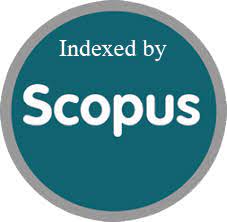Targeting Dopamine Receptors with Costunolide: A Computational Approach Toward Selective Neuroprotection
Keywords:
Costunolide, ADMET, in-silico, receptor, CYP2C19, molecular dockingAbstract
Background: Costunolide, a neuroprotective and anti-inflammatory sesquiterpene lactone, may be utilized for tailored dopaminergic therapy. Molecular docking studies show that, in contrast to Tetrandrine, Eudesmol, and Spathulenol, costunolide possesses high binding receptor receptor and beneficial ADMET characteristics. The most effective modulator of dopaminergic transmission is costunolide because of its low pharmacokinetic risk and high efficiency.
Aim: To evaluate the therapeutic potential and receptor selectivity of costunolide as a dopaminergic modulator through in-silico analysis, including ADMET profiling and molecular docking, for potential application in Parkinson’s disease and related neuropsychiatric disorders.
Methods: An in-silico approach was employed to evaluate costunolide, eudesmol, spathulenol, and tetrandine drug-likeness and receptor interaction profile. ADMET analysis of the drug properties was conducted through SwissADME and the ESOL cheminformatics platform. Molecular docking simulations performed through AutoDock Tools examined receptors dopamine D1 (PDB ID: 7X2D and D2 (PDB ID: 7JVR). Protein and ligand structures were prepared, optimized, and docked, and binding affinities and BIOVIA Discovery Studio facilitated detection of interaction patterns.
Results: The ADMET characteristics of costunolide, eudesmol and spathulenol show excellent absorption, solubility, permeability through blood brain barrier without violating the Lipinski’s Rule. These compounds additionally demonstrated a distinct absence of PAINS alerts. Out of the four compounds, three exhibited CYP inhibition freedom, while spathulenol exhibited inhibition of CYP2C19. Docking simulations of costunolide eudesmol, spathulenol, and tetrandine show -6.1, -5.7, -6.0, and -6.5kcal/mol respectively against D1 receptor and -5.3, -5.5, -6.3, and -7.0kcal/mol respectively against D2 receptor.
Conclusion: Costunolide demonstrates promising therapeutic attributes and moderate selectivity for the dopamine D1 receptor, supported by robust in-silico ADMET and docking analyses. Future investigations including both in vivo efficacy assessments and chemical structure improvements are warranted to unveil therapeutic potency and receptor binding accuracy
Downloads
Metrics
References
Zhuang Y, Xu P, Mao C, Wang L, Krumm B, Zhou XE, et al. Structural insights into the human D1 and D2 dopamine receptor signaling complexes. Cell. 2021;184(4):931-42. e18.
Sharma R, Kour A, Dewangan HK. Enhancements in Parkinson's Disease Management: Leveraging Levodopa Optimization and Surgical Breakthroughs. Current Drug Targets. 2025;26(1):17-32.
He L-Y, Hu M-B, Li R-L, Zhao R, Fan L-H, He L, et al. Natural medicines for the treatment of epilepsy: bioactive components, pharmacology and mechanism. Frontiers in pharmacology. 2021;12:604040.
Samanta S, Chakraborty S, Bagchi D. Pathogenesis of neurodegenerative diseases and the protective role of natural bioactive components. Journal of the american nutrition association. 2024;43(1):20-32.
Rahman MH, Bajgai J, Fadriquela A, Sharma S, Trinh TT, Akter R, et al. Therapeutic potential of natural products in treating neurodegenerative disorders and their future prospects and challenges. Molecules. 2021;26(17):5327.
Egbuna C, Rudrapal M. Phytochemical drug discovery for central nervous system disorders: Biochemistry and therapeutic effects: John Wiley & Sons; 2023.
Behl T, Kaur G, Sehgal A, Singh S, Bhatia S, Al-Harrasi A, et al. Elucidating the multi-targeted role of nutraceuticals: A complementary therapy to starve neurodegenerative diseases. International journal of molecular sciences. 2021;22(8):4045.
Cokdinleyen M, Dos Santos LC, de Andrade CJ, Kara H, Colás-Ruiz NR, Ibañez E, et al. A Narrative Review on the Neuroprotective Potential of Brown Macroalgae in Alzheimer’s Disease. Nutrients. 2024;16(24):4394.
Kar S, Leszczynski J. Open access in-silico tools to predict the ADMET profiling of drug candidates. Expert opinion on drug discovery. 2020;15(12):1473-87.
Daoud NE-H, Borah P, Deb PK, Venugopala KN, Hourani W, Alzweiri M, et al. ADMET profiling in drug discovery and development: perspectives of in-silico, in vitro and integrated approaches. Current Drug Metabolism. 2021;22(7):503-22.
Jia L, Gao H. Machine Learning for in-silico ADMET prediction. Artificial Intelligence in Drug Design. 2022:447-60.
Kumar A, Kini SG, Rathi E. A recent appraisal of artificial intelligence and in-silico ADMET prediction in the early stages of drug discovery. Mini Reviews in Medicinal Chemistry. 2021;21(18):2788-800.
Acharya B, Chaijaroenkul W, Na‐Bangchang K. Therapeutic Potential and Pharmacological Activities of β‐eudesmol. Chemical biology & drug design. 2021;97(4):984-96.
Dos Santos E, Radai JAS, do Nascimento KF, Formagio ASN, de Matos Balsalobre N, Ziff EB, et al. Contribution of spathulenol to the anti-nociceptive effects of Psidium guineense. Nutritional Neuroscience. 2022;25(4):812-22.
Kim DY, Choi BY. Costunolide—A bioactive sesquiterpene lactone with diverse therapeutic potential. International journal of molecular sciences. 2019;20(12):2926.
Choi Y-J, Choi YK, Ko S-G, Cheon C, Kim TY. Investigation of molecular mechanisms involved in sensitivity to the anti-cancer activity of costunolide in breast cancer cells. International Journal of Molecular Sciences. 2023;24(4):4009.
Bhagya N, Chandrashekar K. Tetrandrine–A molecule of wide bioactivity. Phytochemistry. 2016;125:5-13.
Rasul A, Parveen S, Ma T. Costunolide: A novel anti-cancer sesquiterpene lactone. Bangladesh Journal of Pharmacology. 2012;7(1):6-13.
Grieco PA, Nishizawa M. Total synthesis of (+)-costunolide. The Journal of Organic Chemistry. 1977;42(10):1717-20.
Xie Q-M, Tang H-F, Chen J-Q, Bian R-L. Pharmacological actions of tetrandrine in inflammatory pulmonary diseases. Acta Pharmacologica Sinica. 2002;23(12):1107-13.
Ferreira LL, Andricopulo AD. ADMET modeling approaches in drug discovery. Drug discovery today. 2019;24(5):1157-65.
Mahnashi MH, Alshahrani MA, Nahari MH, Hassan SSu, Jan MS, Ayaz M, et al. In-vitro, in-vivo, molecular docking and ADMET studies of 2-substituted 3, 7-dihydroxy-4H-chromen-4-one for oxidative stress, inflammation and Alzheimer’s disease. metabolites. 2022;12(11):1055.
Arslan ME, Türkez H, Sevim Y, Selvitopi H, Kadi A, Öner S, et al. Costunolide and parthenolide ameliorate MPP+ induced apoptosis in the cellular Parkinson’s disease model. Cells. 2023;12(7):992..
Downloads
Published
How to Cite
Issue
Section
License

This work is licensed under a Creative Commons Attribution 4.0 International License.
You are free to:
- Share — copy and redistribute the material in any medium or format
- Adapt — remix, transform, and build upon the material for any purpose, even commercially.
Terms:
- Attribution — You must give appropriate credit, provide a link to the license, and indicate if changes were made. You may do so in any reasonable manner, but not in any way that suggests the licensor endorses you or your use.
- No additional restrictions — You may not apply legal terms or technological measures that legally restrict others from doing anything the license permits.






